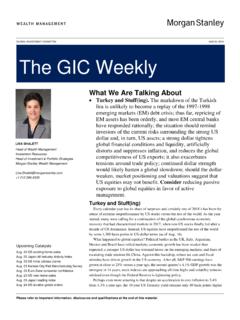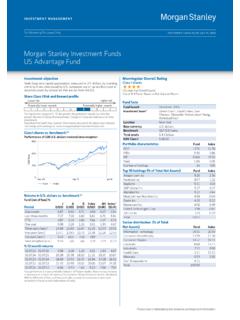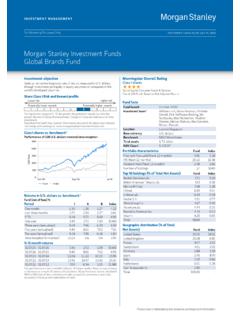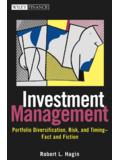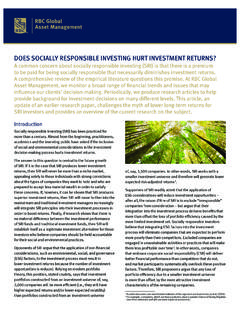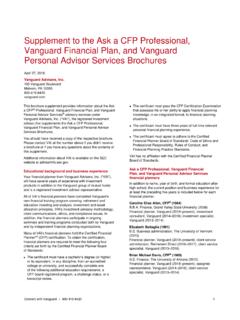Transcription of RESEARCH WEALTH MANAGEMENT INVESTMENT …
1 RESEARCH WEALTH MANAGEMENT INVESTMENT RESOURCES JANUARY 17, 2018 morgan stanley WEALTH MANAGEMENT is the trade name of morgan stanley Smith Barney LLC, a registered broker-dealer in the United States. morgan stanley WEALTH MANAGEMENT does and seeks to do business with companies covered in morgan stanley WEALTH MANAGEMENT RESEARCH . As a result, investors should be aware that the firm may have a conflict of interest that could affect the objectivity of morgan stanley WEALTH MANAGEMENT RESEARCH . Investors should consider morgan stanley WEALTH MANAGEMENT RESEARCH as only a single factor in making their INVESTMENT decision. For analyst certification and other important disclosures, refer to the Disclosure Section, located at the end of this report. Municipal Bond Monthly NORTH AMERICA MATTHEW GASTALL Executive Director morgan stanley WEALTH MANAGEMENT +1 212 296-2602 *Special thanks to Ayden Syal for his contribution to this report.
2 Strategy: Low Ratios and Rate Weakness Suggest Caution Consider Entry Points Once Weakness Stabilizes Favor High Quality; Keep Some Dry Powder Credit Quality: High Favored Sectors: See our Sector Outlooks Table Duration: Short/Low-to -Neutral Coupon Structure: or Higher Fig 1. Home Again Ratios Settle Below Averages Source: morgan stanley WEALTH MANAGEMENT Municipal RESEARCH and Strategy, Bloomberg, Thomson Reuters Municipal Market Data (MMD) as of 1/16/18 Back Home Again Hey, it s good to be back home again .. Great song, right? John Denver s lyrics capture the visceral sentiment that many of us feel whenever we journey home to visit friends and family. Though as many of us who travel long distances can attest to, the nostalgic feeling of the return is indescribable, but even the familiar setting of home gradually changes as time goes on.
3 As we will elaborate upon shortly, our market is inarguably "back home again" in a number of important ways; however, as familiar as this environment may be, the journey is always a new one moving forward. What does this mean that the market is back home once again? Allow us to Importantly, what last year s tax reform legislation (the Tax Cuts and Jobs Act of 2017) didn t do may be far more material than what it actually did. Though the legislation may gradually mold the landscape of the market moving forward, the package held the potential to have a far more significant impact on investor sentiment and market pricing, particularly in the short term. Alongside the factors discussed in our recent publications, two important concerns were assuaged: (1) no material changes were made to the municipal bond tax exemption; and (2) personal income tax reductions appeared low enough to have a neutral impact on household demand.
4 (Although these dynamics have bolstered th e market and are important to our discussion, please review the considerations listed in our Tax-Reform Breakdown Table as well.) As the market recognized that such possibilities were becoming realities, investor sentiment transitioned back home. One of the most important, and even overlooked, developments of 2017 was the long-awaited return of municipal relative-value ratios to their long-term historical averages versus US Treasuries (USTs). These ratios represent how tax-exempt securities are valued versus their taxable counterparts, and exhibit that the asset class has yielded more, or traded weaker, than USTs for most of the last eight years. This sentiment surfaced for a variety of reasons, but we believe it should be greatly attributed to the American Jobs Act s 2011 proposal to cap the value of the municipal exemption at 28%.
5 Consequently, investors discounted the possibility that a change, albeit minor, to the federal exemption was possible. Once this concern was assuaged, ratios returned to familiar territory. In fact, 10-year ratios have averaged just over 84% of USTs since last October, which marks the most extended period of comparative strength enjoyed by the asset class since 2010. In essence, the preservation of the exemption, coupled with tax-reduction clarity, helped th e asset class to return home again. 708090100110120130 Yield % of Corresponding USTs 10-Yr Rel-Val30-Yr Rel-Val RESEARCH MUNICIPAL BOND MONTHLY JANUARY 17, 2018 For analyst certification and other important disclosures, refer to the Disclosure Section, located at the end of this report. 2 Before delving into our INVESTMENT strategy, it is important to stress that the aforementioned dynamic, as familiar as it may be, introduces variables that investors should consider.
6 Though current ratios indicate that bond pricing has returned to familiar territory, they also exhibit that the market is priced just so which hints that municipals have less room to potentially advance versus USTs moving forward. Should USTs continue to weaken (and interest rates rise), the market will approach a threshold where crossover investors will likely sell tax-exempt securities to increase their exposure to taxable ones. Quite simply, the more expensive municipals become, the more sensitive they will be to any future UST weakness. What does this mean? For the first time in many years, this "home again" starting point suggests that municipal investors must pay even more attention to the global interest rate environment. It's always challenging to determine when and if a period of UST weakness will occur, but we must acknowledge the presence of potential catalysts (some are new) at the current juncture.
7 The aforementioned include a weaker US dollar, stronger commodity prices, a hawkish European Central Bank (ECB), concerns of reduced UST INVESTMENT from China and, importantly, the potential return of the reflation trade if explicit details of a federal infrastructure package emerge. Indeed, a stimulus package has the potential to reverse short-term investor sentiment, increase inflationary expectations, elevate federal debt levels, and even foster anxieties about US deficit spending all of which could cause interest rates to rise. Combining the aforementioned dynamics, we would focus on three objectives as we begin the year: (1) exercise caution in the current period of low relative value and interest rate weakness; (2) cautiously consider entry points once present UST weakness stabilizes; and (3) favor high-quality securities and keep some powder dry.
8 First, though absolute yield levels hover near the appealing levels we ve experienced since October, low relative-value ratios hint that the muni market may have little choice but to follow US Treasuries if they continue to weaken. Consequently, investors should exercise caution in the coming weeks. Since we elaborated upon this dynamic earlier, we can swiftly transition this discussion to our second focus: Moving forward, we believe investors can carefully consider adding exposure once the current period of weakness stabilizes. Though we would by no means cannonball in, higher absolute yield levels suggest that prudently adding some exposure for carry (earning interest) may be beneficial; however, waiting for UST stability with ratios as low as they are should help investors to heed the old adage of not catching a falling knife.
9 Lastly, we continue to advocate that investors focus on high-quality municipal securities at this time. Though we discuss this topic often, we believe this advocacy supports a proper balance between risk and reward as: (1) investors are currently compensated less for taking credit risk due to tight spreads; while (2) lower-rated credits may experience challenges and/or spread widening if the economy is in a late cycle. Consistent with the recommendations of morgan stanley WEALTH MANAGEMENT s Global INVESTMENT Committee, we also favor bonds with short/low-to -neutral duration for buy-and-hold investors. Tactical investors may wish to consider higher durations, but private clients should note that 83% of the yield curve is currently captured by the 12-year maturity.
10 As discussed last month, we feel that employing a bond ladder strategy of high-quality, short-to -neutral duration municipal securities can function as an effective intermediary between earning yield and taking excessive interest rate risk. Finally, we'd stress that investors leave some dry powder for the possibility of any future rate weakness due to the aforementioned catalysts. After receiving some clarity about the municipal bond tax exemption and federal income tax reductions, our market seems to be home again for the first time in nearly eight years. Though the setting is familiar, the journey will still be a different one moving forward .. as it always is. Monthly Spotlight State of New York (Credit Update) As discussed in last February s publication, the state s credit strengths include its inherent dominion over one of the nation s largest economies, which is bolstered by the productivity of the New York metropolitan area.

